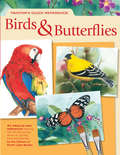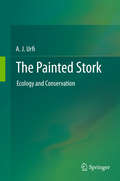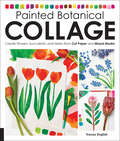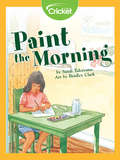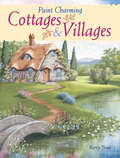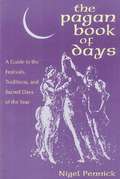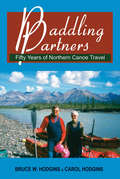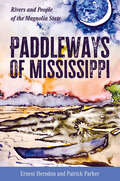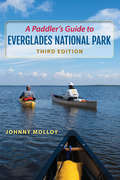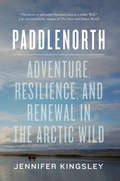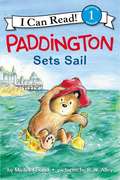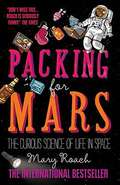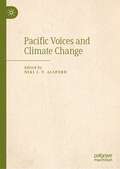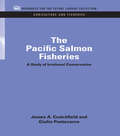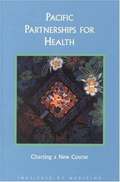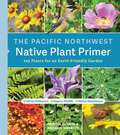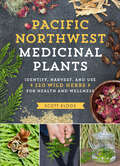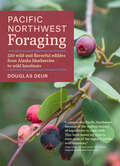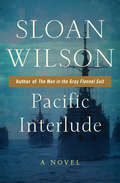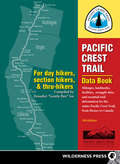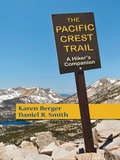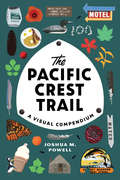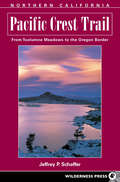- Table View
- List View
Painter's Quick Reference Birds & Butterflies: Birds And Butterflies
by Editors of North Light BooksThe perfect reference for painters! Brighten your paintings with colorful birds and butterflies. Inside you'll find more than 40 step-by-step demonstrations to help you accurately render beautiful butterflies and a wide variety of songbirds, water birds and exotic birds including goldfinches, hummingbirds, cardinals, mallards and peacocks. You'll also learn how to embellish your paintings with individual feathers, eggs and a nest. This special guide features painting instruction and advice from 11 professional artists working in acrylics, watercolors, oils and colored pencils. Each demonstration includes a detailed materials list to make it even easier for you follow along. This invaluable combination of in-depth painting demonstrations and inspiring ideas is guaranteed to bring you success in all your work.
The Painted Stork
by A. J. UrfiThe book will cover the entire range of the Painted Stork--beyond its stronghold in India and Sri Lanka to other countries--E Asia as well. For the sake of comparison, relevant information will be included about the other species of storks--both solitary as well as colonial, of Asia, as well as those in other parts of the world. Certainly plenty of references will be made about the work done on the American Wood Stork. Studies are underway in order to better understand the role of the monsoon rains on the nesting pattern of Painted Stork, besides attempting a review of the global status of the species. The former is likely to be of interest in augmenting our understanding about how global climate change is going to affect birds across India and the second is likely to raise interesting points about the distribution of species and their ranges. Both these studies will be carried through 2009 and should hopefully be included in the proposed book. Naturally, the focused interest in field research on the Painted Stork has resulted in accumulation of considerable information on this particular species, which is beyond the information contained on some standard Indian and international works and ornithological texts. The author hopes to include the entire spread of information of this species--from its systematics, evolution, distribution, ecology to its role in human culture as well as its association with mythologies. In other words, topics have not been restricted to the areas of the author's research but have spilled over into areas of anthropology, ecology, conservation, etc.
Painted Botanical Collage: Create Flowers, Succulents, and Herbs from Cut Paper and Mixed Media
by Tracey EnglishWith Painted Botanical Collage, artists of all skill levels will learn to create lifelike botanical artwork—featuring flowers, succulents, and herbs—using painted background papers and elegant collage techniques. A unique technique book, Painted Botanical Collage will show you how to create your own collage materials. This guide takes you step by step through creating mixed-media painted papers, then using them—along with tissue paper, art papers, and found paper, such as magazines—to create perfect collage materials. Cut these decorative papers into plant and flower parts to assemble your designs, adding details using various media.Working from nature is central to this technique—look closely at the palettes and shapes in actual flowers to create realistic stylized representations. Painted Botanical Collage includes instruction on creating flowers, cacti, succulents, leaves, and other popular botanicals—over 30 beautiful designs in all. Join in the fun as British artist Tracey English shares the methods behind the magical flower collages that charm and delight her Instagram followers.
Paint the Morning
by Sandi TakayamaMalia is not interested in drawing monsters or sculpting pots. All she wants to do is paint the morning.
Paint Charming Cottages & Villages
by Kerry TroutCapture the Charm of Cottage and Village ScenesBring the storybook cottages and towns of your dreams to life. Ten step-by-step projects show you how to paint a variety of architectural styles from a Victorian "gingerbread" house, to an English Tudor cottage, to a Cape Cod and a classic farmhouse. Two nostalgic village scenes take you back to simpler days of main streets lined with merchants, dress shops and tearooms.Dozens of quick mini-demonstrations show you how to embellish your scenes with quaint details, including porch swings, lace curtains, fountains, old-time lampposts, picket fences and quilts fluttering on a clothesline. You'll also learn how to add the seasonal touches of fall foliage, spring flowers and winter snows.Each project is painted with acrylic paints. Full-color photos, traceable patterns, color swatches, detailed materials lists and a techniques section make each painting easy to do. Use your paintbrush and these projects to create your own quaint getaway cottages today!
The Pagan Book of Days: A Guide to the Festivals, Traditions and Sacred Days of the Year
by Nigel PennickThe Pagan Tradition is grounded in mystical and numinous elements existing between matter and spirit. The world over it is called something like "the old religion," or "the elder faith," acknowledging its senior status among religions. It places emphasis on the links between people, their land, and the natural cycles of the seasons.
PADI Open Water Diver manual 2006 Edition
by Editors at the PADIThe PADI Open Water Diver course consists of three segments: Confined water dives, knowledge development, and open water dives. Each plays an important role in learning to dive and in meeting the performance objectives you need to qualify as a diver. Knowledge development establishes the principles and basic information all divers need to have fun diving safely. It's divided into five segments that you'll complete primarily on your own time at your convenience using this manual and the PADI Open Water Diver Video. (In some instances you may view or review the video in a classroom setting.) For each segment, your instructor reviews and elaborates on the material, applying what you're learning to your specific needs, interests and the local dive environment. A short quiz confirms that you've picked up the information you need from that section.
Paddling Partners: Fifty Years of Northern Canoe Travel
by Bruce W. Hodgins Carol HodginsCarol and Bruce Hodgins began leading canoe trips in 1957 for Camp Wanapitei on Lake Temagami in Northern Ontario, initially to the great rivers of that region and on into Quebec. Their first venture north of 60 found them on the South Nahanni, soon to be followed by the Coppermine River, and by the 1990s their annual tripping took them to the Soper River on Baffin Island. included with their richly descriptive accounts of wilderness travel with groups of people, are kayak adventures in Baja California, Mexico, and the Queen Charlottes, paddling in and near the Everglades and explorations on Heritage rivers in the Maritimes and along the coast of Newfoundland. Few have personally experienced the breadth of wilderness travel in Canada as have the Hodgins husband-and-wife team. Their fifty years as "paddling partners," a legendary achievement, is a story of shared joys, challenges, triumphs and mishaps, delightfully told and augmented by excerpts from daily logs, historical insights and the tidbits of experience gleaned over the years.
Paddleways of Mississippi: Rivers and People of the Magnolia State
by Ernest Herndon Patrick ParkerMississippi rivers and creeks have shaped every aspect of the state’s geology, ecology, economy, settlement, and politics. Mississippi's paddleways—its rivers, rills, creeks, and streams—are its arteries, its lifeblood, and the connective tissues that tie its stories and histories together and flood them with a sense of place and impel them along the current of time. The rivers provide structure for the telling of stories. In Paddleways of Mississippi: Rivers and People of the Magnolia State, readers will discover flowing details of virtually every waterway in the state—the features, wildlife, vegetation, geology, hydrology, and specific challenges to be expected—alongside many wonderful historical and social accounts specific to each system. Interviews and oral histories enliven these waterways with evocative scenery, engaging anecdotes, interesting historical tales, and personal accounts of the people and communities that arose along the waterways of Mississippi. Part natural history, part narrative nonfiction, Paddleways of Mississippi will appeal to outdoor enthusiasts, anglers, naturalists, campers, and historians, and is suitable for novices as well as experts. Told together, the pieces included are a social and ecological history that exposes and deepens the connection coursing between the people and the rivers.
A Paddler's Guide to Everglades National Park
by Johnny MolloyWhether forging uncharted territory or slipping along marked canoe trails, get ready to experience more than 400 miles of creeks, bays, marshes, and the Gulf of Mexico. This indispensable guide for the ultimate adventure by canoe or kayak now includes GPS coordinates and twelve new paddle routes.
Paddlenorth
by Jennifer KingsleyIn an adventure of a lifetime, Jennifer Kingsley and her five companions canoe through one of the planet's most rugged settings. They battle raging winds, impenetrable sea ice, treacherous rapids, and agonizing sores and blisters while contending with rising tensions among the group. But they also experience the lasting joy of grizzly sightings, icy swims, and the caribou's summer migration. Woven through this spellbinding narrative are often-harrowing accounts of the journeys of earlier explorers, some of whom never made it back home. Paddlenorth paints an indelible portrait of the spectacular Arctic landscape, rendered with a naturalist's eye and an artist's sensibility, and offers an eloquent exploration of how wilderness changes us.
Paddington Sets Sail (I Can Read Level 1 Ser.)
by Michael Bond R. W. AlleyPaddington Bear has charmed readers of all ages for almost 60 years! Now part of the I Can Read line, Michael Bond’s classic character will delight beginning readers with his curious nature and nose for adventure. Paddington is thrilled to go to the beach with the Browns. He’s never splashed in the ocean or built a sand castle. Outfitted with a new set of beach toys, Paddington seems ready for whatever comes his way. But the biggest surprise of all sweeps Paddington off on a new adventure. Paddington Sets Sail is a Level One I Can Read book, which means it’s perfect for children learning to sound out words and sentences.
Packing for Mars: The Curious Science of Life in Space
by Mary RoachWhat happens when you vomit during a space walk? The bestselling author of Stiff explores the irresistibly strange universe of space travel and life without gravitySpace is devoid of the stuff humans need to live: air, gravity, hot showers, fresh veg, privacy, beer. How much can a person give up? What happens when you can't walk for a year? Is sex any fun in zero gravity? What's it like being cooped up in a metal box with a few people for months at a time? As Mary Roach discovers, it's possible to explore space without ever leaving Earth. From the space shuttle training toilet to a 17,000 mile-per-hour crash test of NASA's space capsule (cadaver stepping in), she takes us on a surreally entertaining trip into the science of living in space.
Pacific Voices and Climate Change
by Niki J. P. AlsfordThis book provides a comprehensive overview of issues related to climate change in the Pacific and will be an invaluable reference for those working in this important field. Climate change represents humanity’s greatest threat. The vastness of the Pacific means that no two experiences are the same. This edited volume identifies research that highlights the local impact of climate change on the islands and coastlines of the Pacific. The authors use current research to document climate change via contextually informed studies that engages with local cultures, histories, knowledges, and communities. The transdisciplinary nature and the combination of both academic and non-academic writing makes this book an accessible and important contribution to the field.
The Pacific Salmon Fisheries: A Study of Irrational Conservation (RFL Agriculture and Fisheries #3)
by James A. Crutchfield Giulio PontecorvoThis study attributes the chronic economic distress of the valuable Pacific salmon industry not only to decline in catch but also to the economic problems of open access ocean fisheries. It analyzes salmon public management programs and proposes alternatives. Originally published in 1969
Pacific Partnerships for Health: Charting a Course for the 21st Century
by Jill C. Feasley Robert S. LawrenceThe U.S.-Associated Pacific Basin consists of six island jurisdictions: American Samoa, the Commonwealth of the Northern Mariana Islands, Guam, the Federated States of Micronesia, Republic of the Marshall Islands, and the Republic of Palau. This book examines one aspect of the ties and U.S. involvement with this part of the world--its role in the region's health care delivery system. Although the health status of the islanders and the challenges faced by the health care systems naturally vary within and among the jurisdictions, in general, almost all health indicators for the islanders are worse than those of mainland Americans. The health systems in the area must deal with conditions normally seen in developing countries (e.g., malnutrition, tuberculosis, dengue fever, and cholera) and in developed countries alike (e.g., diabetes, heart disease, and cancer). In examining the strengths and weaknesses of the area's systems, the volume provides a regional health overview and assessments of health care in individual jurisdictions, evaluates the Pacific Basin Medical Officers Training Program, and lays out a strategic plan for future health services in the U.S.-Associated Pacific Basin.
The Pacific Northwest Native Plant Primer: 225 Plants for an Earth-Friendly Garden
by Kristin Currin Andrew MerrittNative plants bring your garden to life—and life to your garden! Here are the best choices for Oregon and Washington. The benefits of native plants are enormous—they reduce maintenance, require less water, and attract vital, earth-friendly pollinators like birds, butterflies, and bees. Gardeners seeking to add them to their landscape will find no better guide than The Pacific Northwest Native Plant Primer. Packed with proven advice that everyhome gardener can follow, this incomparable sourcebook profiles 225 recommended native wildflowers, grasses and grasslike plants, ferns, shrubs, and trees. With additional introductory information on preparation, planting, maintenance, and climate considerations, it&’s everything you need to know to create a beautiful and beneficial garden. This must-have handbook is for gardeners in Oregon, Washington, and southern British Columbia.
Pacific Northwest Medicinal Plants: Identify, Harvest, and Use 120 Wild Herbs for Health and Wellness
by Scott Kloos“An incredibly thorough guide for identifying, harvesting, and utilizing medicinal plants.” —Dr. Deborah Frances RN, ND Naturopathic physician, herbalist, author, and lecturer In Pacific Northwest Medicinal Plants, Scott Kloos is your trusted guide to finding, identifying, harvesting, and using 120 of the region’s most powerful wild plants. You’ll learn how to safely and ethically forage, and how to use wild plants in herbal medicines including teas, tinctures, and salves. Plant profiles include clear, color photographs, identification tips, medicinal uses and herbal preparations, and harvesting suggestions. Lists of what to forage for each season makes the guide useful year-round. Thorough, comprehensive, and safe, this is a must-have for foragers, naturalists, and herbalists in Oregon, Washington, Alaska, and northern California.
Pacific Northwest Foraging: 120 Wild and Flavorful Edibles from Alaska Blueberries to Wild Hazelnuts (Regional Foraging Series)
by Douglas Deur“Doug Deur invites us to discover the taste and history of the Northwest.” —Spencer B. Beebe, author of Cache and founder of Ecotrust The Pacific Northwest offers a veritable feast for foragers, and with Douglas Deur as your trusted guide you will learn how to safely find and identify an abundance of delicious wild plants. The plant profiles in Pacific Northwest Foraging include clear, color photographs, identification tips, guidance on how to ethically harvest, and suggestions for eating and preserving. A handy seasonal planner details which plants are available during every season. Thorough, comprehensive, and safe, this is a must-have for foragers in Oregon, Washington, and Alaska.
Pacific Interlude: A Novel
by Sloan WilsonDuring the last days of World War II, a young officer braves enemy fire and a maverick crew on the open waters and in the steamy ports of the South Pacific Twenty-five-year-old Coast Guard lieutenant Sylvester Grant, a veteran of the Greenland Patrol, has just been given command of a small gas tanker, running shuttle and convoy duties for the US Army. Sally, his wife of three years, is eager for him to get back to Massachusetts and live a conventional suburban life selling insurance--but Syl longs for adventure and is bound to find it as the captain of a beat-up, unseaworthy vessel carrying extremely flammable cargo across dangerous stretches of the Pacific Ocean. As the Allies prepare to retake the Philippines, the only thing the sailors aboard the Y-18 want is for the war to be over. First, however, they must survive their mission to bring two hundred thousand gallons of high-octane aviation fuel to shore. From below-deck personality clashes to the terrifying possibility of an enemy attack, from combating illness and boredom to the constant stress of preventing an explosion that could blow their ship sky high, the crew of the Y-18 must learn to work together and trust their captain--otherwise, they might never make it home. Based on Sloan Wilson's own experiences, Pacific Interlude is a thrilling and realistic story of World War II and a moving portrait of a man looking toward the future while trying to survive a precarious present.
Pacific Crest Trail Data Book
by Benedict GoThe essential, cut-to-the-chase handbook to the Pacific Crest Trail, based on the comprehensive Wilderness Press guidebooks to the PCT, has been completely updated. Packed with trail-tested features, it's useful both on and off the trail, covering pre-trip planning for resupply stops, how to set daily on-the-trail mileage goals by knowing trail gradient and the locations of campsites, water sources, and facilities, and how to easily calculate distances between any two points on the trail, and how to planning both north-bound and south-bound hiking trips.
The Pacific Crest Trail: A Hiker's Companion (Second Edition)
by Karen Berger Daniel R. SmithThis book begins where basic trail guides and maps leave off. For each section of the trail, the authors describe the route in detail and recommend the best day hikes and short backpacks from each trailhead. They describe the plants and animals hikers will see, tell stories about local history, explain plate tectonics, and in a thousand other ways enrich your experience of the journey. For many people, the Pacific Crest Trail is the ultimate long-distance hiking trail. Beginning in the dry valleys of southern California, it follows the crest of the snow-capped Sierras and ends in the ancient forests of Washington's Cascades. Along the way, national treasures such as Yosemite, Crater Lake, and Mount Rainier make this trail one of the premier hiking destinations in the world. But hiking is about much more than getting from A to B. Berger and Smith draw on their tremendous experience--together they have logged more than 12,000 miles on the PCT--to give tested advice to long-distance hikers on trip planning, gear and safety, seasonal considerations, trailheads and resupplies, permits, and much more.
The Pacific Crest Trail: A Visual Compendium
by Joshua M. PowellThe Pacific Crest Trail as you've never seen it before! A visual feast for the senses, this highly designed paperback showcases the PCT through clever infographics, modern illustration, and insightful text. The book captures both the grandeur of the West Coast as well as the tiniest things that a thru-hiker notices and experiences during a 140-day trek.Through the written word, graphic design, and illustration, The Pacific Crest Trail: A Visual Compendium conveys the beauty and the beastliness of a 2,650-mile wilderness hike from Mexico to Canada. The author chronicles the PCT through infographics about the trail and the thru-hikers' experience, and includes arresting illustrations of the landscape and minutiae of the trail. Everything from trail markers, weather challenges, and the stories behind popular toponyms to the songs stuck in a hiker's head, thru-hiker trail names, and food consumed will be addressed, making this an ideal gift for any outdoor enthusiast.
Pacific Crest Trail: Northern California
by Jeffrey P. SchafferFrom the time the PCT leaves the Mexican border, until it reaches Canada, it has traveled 2,650 miles through 24 national forests, 37 wilderness areas, and 7 national parks. In Pacific Crest Trail: Northern California, you'll meet up with the PCT in Yosemite National Park's Tuolumne Meadows, then hike, climb, descend, and switchback your way to the Oregon border. You'll discover rivers, peaks, forests, meadows, fascinating geological formations, and other natural wonders. You'll pass through Emigrant, Desolation, and Marble Mountain wildernesses; Trinity Alps and Lassen National Park; and, you'll see Lake Tahoe, Burney Falls, Mt. Shasta, and Castle Crags. This book helps you locate the PCT and side-trips, find water sources, and access resupply routes. Jeffrey P. Schaffer also describes the rich geological and natural history of these mountains. Information on camping, permits, and the best seasons to go is provided along with updated maps.
